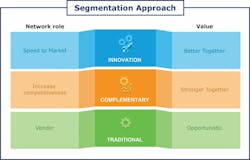The pharmaceutical supply chain is the sum of the all steps required for the production and distribution of medicines.
The Janssen Supply Chain comprises of a network of global manufacturing sites, in addition, entrusts supply contracts to more than 100 external partners.
If pharmaceutical companies want to evolve their external supply partnerships for the better, they have to start by asking themselves tough questions, with brutally honest answers: How can we drive the most value for our patients? Is the status quo working? Can we be doing things better, faster, more efficiently?
These frank discussions can lead to a transformation and allow pharmaceutical companies to approach contract manufacturing like a true partnership rather than primarily a cost-saving measure. Ultimately, the goal is to ensure that patients benefit from this shift in strategy.
And for the company, the right partnership can bring about unexpected innovations, process improvements, better efficiency and lower costs.
The Mindset Shift
The early contract manufacturing organization (CMO) model is often focused on cost-capacity — where more volume means a lower-cost/unit product. Among big pharma, there has been a preference to do everything internally — only looking to external suppliers if pharma doesn’t possess the resources to do the job.
New innovations in treatments have enabled many pharmaceutical companies to think about a new way to approach external manufacturing. It’s not an automatic or speedy shift, however. So it’s important to spend a significant amount of time reviewing your company’s network of suppliers and getting a solid understanding of how the process could be improved.
The External Supply Evolution
Often, this approach is born out of a need to address the challenges many pharmaceutical companies face — namely that new innovation or technology create challenges in production. It’s often beneficial to be forced to think differently, and that has resulted in a shift in our internal and external mindsets from a more tactical approach to a true partnership strategy.
The shift to this model can take many years and intense internal review. Companies can begin their own journey in this process by first looking at where the company already excelled, and where a partnership might lend itself to performing certain tasks better. Companies can then select several external partners, each having been carefully evaluated and cultivated to complement the work they do internally.
For Janssen, the path forward ultimately boiled down to four factors — or value drivers — that were used to evaluate and approach external partnerships: innovation, agility, cost competitiveness and risk sharing.
- With innovation, the company wanted to see how partnerships could accelerate the development of new treatments and get them into the hands of patients more quickly and efficiently with the same high level of quality.
- Considerations around agility were centered on the lifecycle of new products, and whether there was a smarter way to partner with an external manufacturer from the beginning to the end of the product lifecycle.
- Cost competitiveness is a key concern, particularly because big companies can find efficiencies by working with partners that have systems already in place.
- Risk sharing is viewed in a similar light, with external manufacturers attempting to mitigate risk in the development of new technologies.
Approaching the idea of external partnerships in a thoughtful way ensured that Janssen was being strategic and deliberate. It really boils down to making sure these partnerships are the right strategic and cultural fit.
Seeing Positive Results
External partnerships have already proven to be beneficial across the industry. On a holistic level, these relationships have challenged companies to think about what they are doing, and why they are doing it in a given way. It can be helpful to ask if there is a different way to approach a solution, and if it can be done better. Big companies work diligently to ensure stability of their processes and mitigate any potential risk, so partnering with a different mindset that you may find at a smaller biotechnology company lets us learn something new and challenge the status quo.
There have been some notable examples of how these partnership strategies have aided companies with the introduction of new products.
One instance was with a treatment that required a new manufacturing component. While the initial instinct was to build our own facility to develop it, the amount of time needed to get a new facility up and running would not have met the demand for the product. Instead, the company identified an external partner that had the capacity to develop this kind of product and partnered with them to develop it. Because they already worked with that technology, this partner also helped improve the product, and mitigate any risk that would have come with being naïve to the process.
Another example has to do with localization. As many companies are aware, some countries require that manufacturing happen within its borders in order for the product to be sold there. When we explored launching a product in some of those markets, our review of the local independent manufacturers in those regions found that they did not meet the desired requirements of quality and reliability that we hold ourselves to. Rather than settle for what we considered to be a subpar solution, we opted in this situation to work with another pharmaceutical company in that region rather than a contract manufacturer. The contract partner we chose to work with to produce the treatment already had an established presence and facility. Manufacturing products in those areas can be very complicated, with rules and issues unique to the region — but working with a company with experience in that area gave them the background and information on how to do it most effectively.
While the notion of working with competitors was not considered first in years past, it can be mutually beneficial — and ultimately benefits patients. The automotive industry went through a similar evolution, where it was once seen as counterintuitive to partner with your business rivals. The arrival of green technology forced a new approach, however. As costs to develop and manufacture hybrid cars became prohibitive, the only solution that made sense was partnerships — and thus, companies started building facilities together and developing technology that could be shared across platforms. Looking at the pharmaceutical industry, more partnerships can ultimately generate more value for patients. It is not a question of if, but when.
The Path Forward
At Janssen, we continue to work through this evolution, and learn lessons along the way. The biggest learning is that this change can only come when everyone in the company is aligned to the process, and when they understand why we want to pursue external partnerships.
These partnerships require just as much oversight and governance as any internal manufacturing process. Our patients trust the quality of our products and that we will deliver what we promise; this is fundamental to our core values. We expect to continue that with external partners, so day one of a working relationship requires establishing rules of engagement and baselines, with a virtual team in place to meet goals. Quality and safety are non-negotiable.
As partnerships become stronger, there will be an opportunity to reduce the number of external partnerships. But, there is still room to grow. We consider Janssen to still be at the beginning of this journey — as is the industry as a whole, where the majority of companies are still working with the traditional external supplier model. The mindset will continue to evolve, though, as more companies look at the value of partnerships and focus less on the risks and any hesitations of work with what have traditionally been viewed as only competitors.
Ultimately, increasing the value we provide to patients will be the driver of this shift. We wanted to explore ways to not just save lives, but also improve the quality of life for our patients — going beyond simply treating diseases to eliminating them and even preventing them altogether. To accomplish this goal, external partnerships — companies working together to accelerate this journey — will be fundamental. If we focus on how we can better help our patients, the rest will follow.






